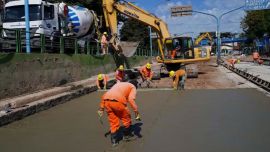A smaller annual crop this year due to drought will impact the economy but there is debate among economists about the extent of the damage.
Without rain on the horizon until the end of March according to climatologists at the Rosario Stock Exchange, crops could come in 10 million tonnes lower in the case of maize. The soy crop has been calculated down by five million tonnes but there are estimates the loss could bring the total harvest down to 40 million.
For representatives from the sectors directly affected, the Rural Society and farming entities in general, the impact will translate into a loss in GDP growth of between 0.5 and one percentage point, of what will be directly lost to drought and activities connected to the sector. For other economist, the drought is impacting GDP growth forecasts but at a more moderate rate of 0.5 to 0.2 percentage point.
Melisa Sala, from LCG, believes that the foreseen impact “will be marginal” at 0.2 percentage point Her forecast for GDP growth in 2018 is quite lower than the government’s: two percentage points against the government’s 3.5.
For Fausto Spotorno, the drought is clearly adding to the drop in GDP forecasts. The OJF y Asociados economist calculates that the reduction will be 0.5 percentage points including the impact of the drought on related activities in the sector. “That’s the worst-case scenario”, he said.
“The crop problem will have an impact in the second quarter”, said Juan Manuel Garzón, economist at Ieral-Fundación Mediterránea. “Producers or parties in the chain of supply are operating with stock crops from previous harvests and it’s probable that they will access those grains to get through this bad patch. That could compensate for the loss in exports and alleviate the generation of foreign exchange income”, he said.
RISKS
The Bolsa de Cereales estimates a harvest of 47 million tonnes for soy and 37 million for maize. In total, that is a year-on-year drop of seven million tonnes as a result of the drought. The last estimates report by the Agro-Industry Ministry did not set a figure but recognised the decline: “If a considerable improvement in climate conditions does not occur in the coming days, (then the impact on crops) could increase”.
The minister of that portfolio Luis Miguel Etchevehere, will meet with representatives from the sector next week. “The national government is monitoring the extent of the drought that is affecting many producers. Once the provinces decree a State of Emergency or an Agriculture Disaster, then the national government will assist as quickly as possible”, he said.
Last week, on Thursday, a Liaison Board created in 2008 to mediate the conflict between the agricultural sector and the Fernández de Kirchner adminstration over increased taxes on exports (Resolution 125), met again.
The possibility of compensating farmers is in the hands of the private sector. The market is managing an estimate of the soy stock from last year’s harvest at 10 million tonnes.
PRICES
The drought is, along with the increased cost of external financing, one of the biggest problems for Argentina this year.
“Any compensation because of the growth in international prices is so far less than the estimated loss in (crop) volume. In the case of soy and its byproducts, we’re seeing a growth of 10 percent in prices but a loss of 15 percent in volume”, economist Juan Llach noted, in a report for the IAE at Austral University.
International soy prices increased 1.4 percent last week to close at US$380.76 per tonne, the highest price in almost a year in Chicago. Maize prices fell 0.3 percent to US$144.19 per tonne while wheat well by 1.2 percent to US$166.18
“There is not going to be enough compensation through price (increases). The drop in production could reach 20 percent and prices have not reached that level of growth”, Garzón added.
The new head of the Rural Society, Daniel Peregrina, predicts less investment this year. This could significantly affect the end of the “boom pick up”, of the selling off trucks and utilities last year.
The lower tax collection on exports will also impact national and provincial coffers if stocked crops remain in silos. Estimates put their value for the tax office at US $7.1 billion.
According to Economía y Regiones, the soy solidarity fund receded 67.9 percent to reached $588 million pesos (US $ 29.37 million). From January 3, funds dried up from eight provinces who did not agree to new terms (Chubut, Corrientes, Santa Fe, San Juan, La Rioja, La Pampa, Jujuy and Mendoza).
The article was originally published in Spanish on Perfil.com























Comments